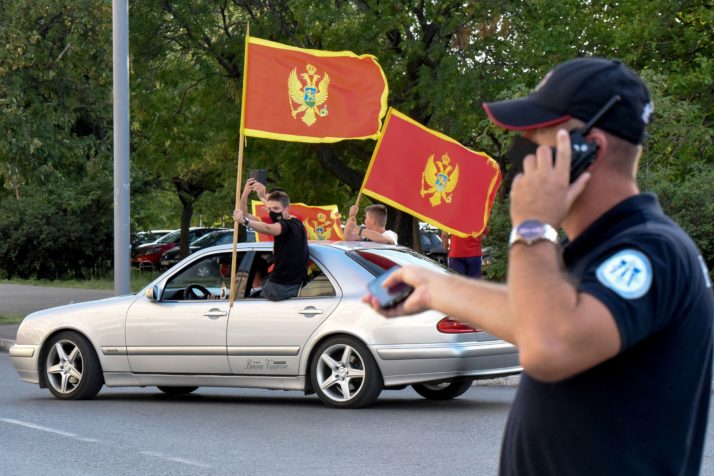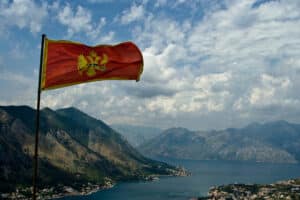Last week’s protest shows that Montenegro is still split between nationalism and religion
The inauguration of the head of the Serbian Orthodox Church in Montenegro, Metropolitan Joanikije, on 5 September 2021 led to riots and violent protests. This was an escalation of ongoing nationalist conflict between sections of the ethnic Serbian population and civic Montenegrin forces. Demonstrators set up barricades to block access routes into Montenegro’s former royal capital Cetinje, a symbol of the Adriatic state’s independence.
The entry of Joanikije and Patriarch of the Serbian Orthodox Church Porfirije required an aggressive police operation with heavily armed officers and a helicopter. It resembled an anti-terrorist operation. Protest rallies in Cetinje had been banned but the police had to use tear gas to keep the angry demonstrators at bay. In these circumstances, a solemn atmosphere for the Metropolitan’s investiture was out of the question. The events laid bare how religion and nationalism have split Montenegrin society and potential violence is simmering.
Serbian provocations
The Democratic Party of Socialists (DPS), in continuity with the League of Communists, has largely run the country since the Second World War. But its dominance was called into question for the first time by the parliamentary elections in August 2020. A coalition of Serbian nationalists (Democratic Front), moderate pro-Serbian forces (Democratic Party) and a small, pro-European, green-tinged party (United Reform Action – URA) were able to form a majority against the DPS and assume the reins of government.
For a year now this unstable coalition has stumbled from one crisis to the next. The only thing holding this heterogeneous alliance together is their opposition to the DPS and its leader Milo Đukanović. As state president, Đukanović remains a thorn in their side. The DPS had attempted to alter the legal position of the Serbian Orthodox Church and its wealth, to curb its power. Its opponents were able to mobilise the ensuing resistance, however, ultimately bringing about the change of government.
Only 30 per cent of the population has been fully vaccinated.
The Covid-19 pandemic has hit Montenegro hard. It has left deep economic scars in a country heavily dependent on tourism. After the abatement of new infections during the summer its seven-day incidence had climbed back up to 702 as of 31 August. Only 30 per cent of the population has been fully vaccinated.
A Covid infection claimed the life of the previous Metropolitan Amfilohije on 7 October 2020. Furthermore, little was done to protect mourners against the virus at his internment and funeral, when head of the Serbian Orthodox Church Irinej was in turn infected and died not long afterwards, on 20 November 2020. The appointment of two new church leaders presented Serbian president Aleksandar Vučić with an opportunity to install supporters of his ‘Serbian World’ agenda. The idea is to spread Serbian influence beyond the borders of the Republic of Serbia to all territories inhabited by Serbs. This applies in particular to Republika Srpska in Bosnia-Herzegovina and also Montenegro. The ‘Serbian World’ agenda feeds the narrative of Serbian nationalism, which was one of the driving forces behind Yugoslavia’s bloody collapse in the 1990s.
Nationalism over EU membership
Montenegro only declared its independence from Serbia as recently as 2006, after a referendum. The margin for independence was very tight, however, with only 55.5 per cent in favour. Many citizens evidently feel more Serbian than Montenegrin. Polarisation between Montenegrins and Serbs is constantly being aggravated by the role and position of the Serbian Orthodox Church. Pro-Serbian forces in Montenegro benefit most from this division of society along religious and nationalist fault-lines. At present, however, civic Montenegrin forces also appear inclined to escalate the conflict.
Against this background, the Serbian Orthodox Church’s decision to stage the investiture in the heavily symbolic old royal capital of Cetinje was inevitably felt as a provocation. On the other hand, President Đukanović’s DPS did little to calm the situation, instead of stoking the flames. Indeed, there is little sign of countervailing influences. Even the pro-European URA, part of the ruling coalition, which in the past has usually acted as a moderating influence on the government’s more radical elements, has done nothing to help. If anything, it exacerbated the polarisation with its vilification of the demonstrators.
The margin for independence was very tight, however, with only 55.5 per cent in favour.
Many observers feared an eruption on 5 September, perhaps setting the country on a downward trajectory towards civil war. That has not happened. Nevertheless, the potential for violent nationalist conflict in Southeast Europe, and especially in Montenegro, is clear. Images of burning barricades, heavily armed police and angry crowds remind many Western observers of the eruptions of violence in the Balkans in the 1990s. All this diverts attention from other areas of political confrontation.
For years now, both Serbia and Montenegro have been immersed in EU accession processes. The rule of law, fighting corruption, media freedom and strengthening democratic institutions are key points of contention and a sluggish reform process. The orchestration of destructive political narratives of nationalism and patriotism is stoking up emotions in Southeast Europe much more than the rather prosaic agenda of EU accession ever could.
Originally from the: IPS-JOURNAL
Author: Dr. Max Brandle
Dr. Max Brändle currently heads the office of the Friedrich-Ebert-Stiftung in Belgrade, Serbia. Previously, he worked in the Central and Eastern Europe Department of the foundation and headed the Friedrich-Ebert-Stiftung in Zagreb, Croatia.
Photo: SAVO PRELEVIC / Contributor



